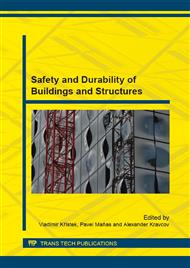[1]
Štoller, Jiří; Maňas, Pavel. Field Test of High Performance Fiber Reinforced concrete slabs. In: International Journal of Building Sustainability and Secure, 2014, vol. 2014, no. 3, pp.42-54. ISSN 2336-4653.
DOI: 10.14311/bss.2014.0016
Google Scholar
[2]
ČSN EN 12390-3. Zkoušení ztvrdlého betonu: Pevnost v tlaku zkušebních těles. Praha: Český normalizační institut, 2001. 20 s.
Google Scholar
[3]
ČSN EN 12390-5. Zkoušení ztvrdlého betonu: Pevnost v tahu ohybem zkušebních těles. Praha: Český normalizační institut, 2001. 12 s.
Google Scholar
[4]
ČSN EN 12390-2. Zkoušení ztvrdlého betonu: Výroba a ošetřování zkušebních těles pro zkoušky pevnosti. Praha: Český normalizační institut, 2001. 8 s.
Google Scholar
[5]
ČSN 73 0038. Navrhování a posuzování stavebních konstrukcí při přestavbách. Praha: Vydavatelství norem Praha, 1986. 32 s.
Google Scholar
[6]
ČSN 73 2011. Nedeštruktívne skúšanie betónových konštrukcií. Praha: Vydavatelství ÚNM, 1988. 36 s.
Google Scholar
[6]
Zezulová, E, Štoller, J. Non-destructive Testing of Materials Used for Protective Structures Built from High Performance Fibre Reinforced Concrete after the Contact Explosion Loading . In: 11th European Conference on Non-Destructive Testing (ECNDT 2014). Brno: Brno University of Technology FME, 2014, pp.1-12.
Google Scholar
[7]
Štoller, J. Využití drátkobetonu pro ochranné stavby. Disertační práce v oboru Vojenské stavby,. Brno: Univerzita obrany – Fakulta vojenských technologií – Katedra ženijních technologií. 2005. 254 s.
DOI: 10.52651/ntpp.b.2022.9788080406301.79-90
Google Scholar
[8]
P. P. Prochazka, A. N. Kravtsov, T. Seng Lok, Assessment of Laminated Cylindrical Arch Loaded by a Shock Wave, International Journal of Protective Structures, Vol. 2, No. 2, June 2011, ISSN 2041-4196, DOI 10. 1260/2041-4196. 2. 2. 267.
DOI: 10.1260/2041-4196.2.2.267
Google Scholar
[9]
P. Maňas, L. Kroupa, R. Urban, D. Coufal, Blast Threat to Critical and Military Infrastructure. Security and Defence Quarterly, 2013, vol. 2013, no. 1, pp.32-53. ISSN 2300-8741.
DOI: 10.35467/sdq/103172
Google Scholar
[10]
Dvořák, P., Štoller, J. Field Tests of High Performance Fiber Reinforced Concrete Slabs.
Google Scholar
[11]
A. Kravtsov, P. Svoboda, Numerical Simulations of Shock Waves in contents of Building Protection and Secure, CTU Publ House 2012, ISBN: 978-80-01-05074-3.
Google Scholar
[12]
P. Maňas, L. Kroupa, The Blast Effects Simulation Tools within Force Protection Engineering and Critical Infrastructure Security. Drilling and Blasting Technology, 2012, vol. 2012, no. September, pp.42-48. ISSN 1788-5671.
Google Scholar


